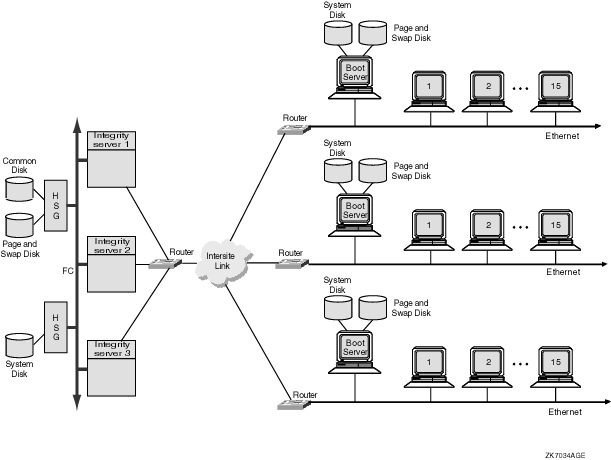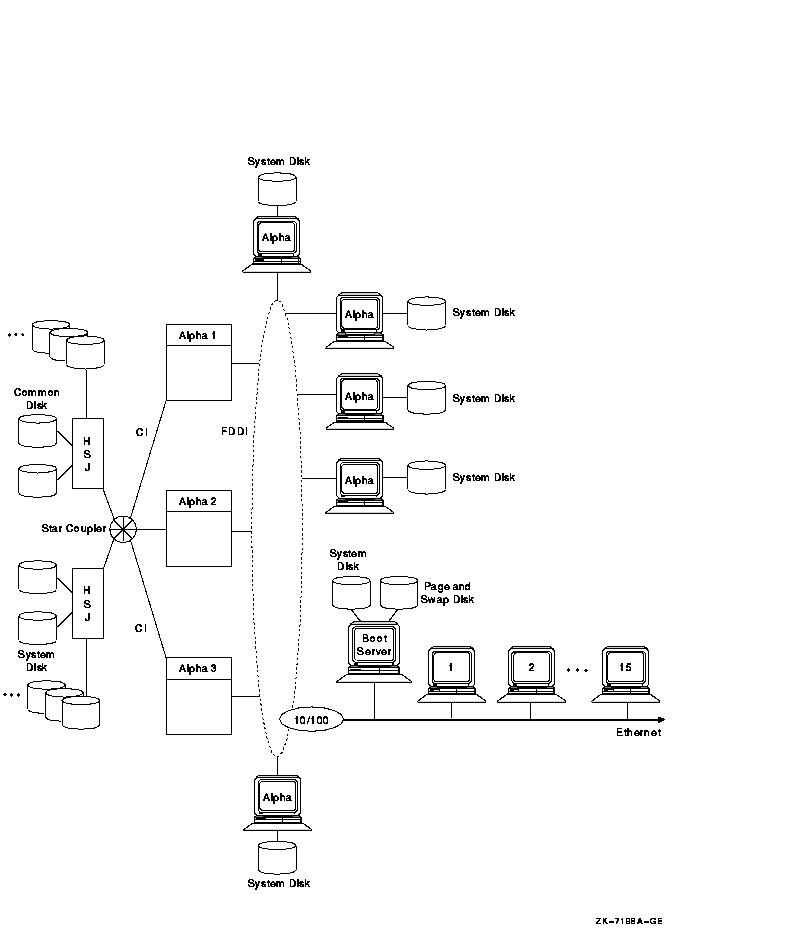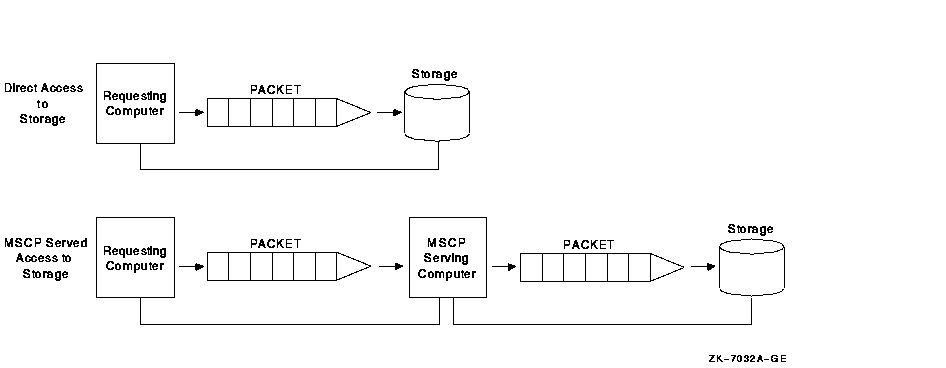| Previous | Contents | Index |
Figure 9-5 shows six satellites and two boot servers connected by Ethernet. Boot server 1 and boot server 2 perform MSCP server dynamic load balancing: they arbitrate and share the work load between them and if one node stops functioning, the other takes over. MSCP dynamic load balancing requires shared access to storage.
Figure 9-5 Six-Satellite LAN OpenVMS Cluster with Two Boot Nodes

The advantages and disadvantages of the configuration shown in Figure 9-5 include:
If the LAN in Figure 9-5 became an OpenVMS Cluster bottleneck, this
could lead to a configuration like the one shown in Figure 9-6.
9.3.3 Twelve-Satellite LAN OpenVMS Cluster with Two LAN Segments
Figure 9-6 shows 12 satellites and 2 boot servers connected by two Ethernet segments. These two Ethernet segments are also joined by a LAN bridge. Because each satellite has dual paths to storage, this configuration also features MSCP dynamic load balancing.
Figure 9-6 Twelve-Satellite OpenVMS Cluster with Two LAN Segments

The advantages and disadvantages of the configuration shown in Figure 9-6 include:
If the OpenVMS Cluster in Figure 9-6 needed to grow beyond its
current limits, this could lead to a configuration like the one shown
in Figure 9-7.
9.3.4 Forty-Five Satellite OpenVMS Cluster with Intersite Link
Figure 9-7 shows a large, 51-node OpenVMS Cluster that includes 45 satellite nodes. The three boot servers, Integrity server 1, Integrity server 2, and Integrity server 3, share three disks: a common disk, a page and swap disk, and a system disk. The intersite link is connected to routers and has three LAN segments attached. Each segment has 15 workstation satellites as well as its own boot node.
Figure 9-7 Forty-Five Satellite OpenVMS Cluster with Intersite Link

The advantages and disadvantages of the configuration shown in Figure 9-7 include:
9.3.5 High-Powered Workstation OpenVMS Cluster (1995 Technology)
Figure 9-8 shows an OpenVMS Cluster configuration that provides high
performance and high availability on the FDDI ring.
Figure 9-8 High-Powered Workstation Server Configuration 1995

In Figure 9-8, several Alpha workstations, each with its own system
disk, are connected to the FDDI ring. Putting Alpha workstations on the
FDDI provides high performance because each workstation has direct
access to its system disk. In addition, the FDDI bandwidth is higher
than that of the Ethernet. Because Alpha workstations have FDDI
adapters, putting these workstations on an FDDI is a useful alternative
for critical workstation requirements. FDDI is 10 times faster than
Ethernet, and Alpha workstations have processing capacity that can take
advantage of FDDI's speed. (The speed of Fast Ethernet matches that of
FDDI, and Gigabit Ethernet is 10 times faster than Fast Ethernet and
FDDI.)
9.3.6 High-Powered Workstation OpenVMS Cluster (2004 Technology)
Figure 9-9 shows an OpenVMS Cluster configuration that provides high performance and high availability using Gigabit Ethernet for the LAN and Fibre Channel for storage.
Figure 9-9 High-Powered Workstation Server Configuration 2004

In Figure 9-9, several Alpha workstations, each with its own system
disk, are connected to the Gigabit Ethernet LAN. Putting Alpha
workstations on the Gigabit Ethernet LAN provides high performance
because each workstation has direct access to its system disk. In
addition, the Gigabit Ethernet bandwidth is 10 times higher than that
of the FDDI. Alpha workstations have processing capacity that can take
advantage of Gigabit Ethernet's speed.
9.3.7 Guidelines for OpenVMS Clusters with Satellites
The following are guidelines for setting up an OpenVMS Cluster with satellites:
You can use bridges and switches between LAN segments to form an extended LAN. This can increase availability, distance, and aggregate bandwidth as compared with a single LAN. However, an extended LAN can increase delay and can reduce bandwidth on some paths. Factors such as packet loss, queuing delays, and packet size can also affect network performance. Table 9-3 provides guidelines for ensuring adequate LAN performance when dealing with such factors.
| Factor | Guidelines |
|---|---|
| Propagation delay |
The amount of time it takes a packet to traverse the LAN depends on the
distance it travels and the number of times it is relayed from one link
to another through a switch or bridge. If responsiveness is critical,
then you must control these factors.
For high-performance applications, limit the number of switches between nodes to two. For situations in which high performance is not required, you can use up to seven switches or bridges between nodes. |
| Queuing delay |
Queuing occurs when the instantaneous arrival rate at switches or
bridges and host adapters exceeds the service rate. You can control
queuing by:
|
| Packet loss |
Packets that are not delivered by the LAN require retransmission, which
wastes system and network resources, increases delay, and reduces
bandwidth. Bridges and adapters discard packets when they become
congested. You can reduce packet loss by controlling queuing, as
previously described.
Packets are also discarded when they become damaged in transit. You can control this problem by observing LAN hardware configuration rules, removing sources of electrical interference, and ensuring that all hardware is operating correctly. The retransmission timeout rate, which is a symptom of packet loss, must be less than 1 timeout in 1000 transmissions for OpenVMS Cluster traffic from one node to another. LAN paths that are used for high-performance applications should have a significantly lower rate. Monitor the occurrence of retransmission timeouts in the OpenVMS Cluster. Reference: For information about monitoring the occurrence of retransmission timeouts, see HP OpenVMS Cluster Systems. |
| Switch or bridge recovery delay |
Choose switches or bridges with fast self-test time and adjust them for
fast automatic reconfiguration. This includes adjusting spanning tree
parameters to match network requirements.
Reference: Refer to HP OpenVMS Cluster Systems for more information about LAN bridge failover. |
| Bandwidth |
All LAN paths used for OpenVMS Cluster communication must operate with
a nominal bandwidth of at least 10 Mb/s. The average LAN segment
utilization should not exceed 60% for any 10-second interval.
For Gigabit Ethernet and 10Gigabit Ethernet configurations, enable jumbo frames where possible. |
| Traffic isolation |
Use switches or bridges to isolate and localize the traffic between
nodes that communicate with each other frequently. For example, use
switches or bridges to separate the OpenVMS Cluster from the rest of
the LAN and to separate nodes within an OpenVMS Cluster that
communicate frequently from the rest of the OpenVMS Cluster.
Provide independent paths through the LAN between critical systems that have multiple adapters. |
| Packet size |
Ensure that the LAN path supports a data field of at least 4474 bytes
end to end. For Gigabit Ethernet devices using jumbo frames, set
NISCS_MAX_PTKSZ to 8192 bytes.
Some failures cause traffic to switch from an LAN path that supports a large packet size to a path that supports only smaller packets. It is possible to implement automatic detection and recovery from these kinds of failures. |
In an OpenVMS Cluster with satellites and servers, specific system parameters can help you manage your OpenVMS Cluster more efficiently. Table 9-4 gives suggested values for these system parameters.
| System Parameter | Value for Satellites |
Value for Servers |
|---|---|---|
| LOCKDIRWT | 0 | 1-4. The setting of LOCKDIRWT influences a node's willingness to serve as a resource directory node and also may be used to determine mastership of resource trees. In general, a setting greater than 1 is determined after careful examination of a cluster node's specific workload and application mix and is beyond the scope of this document. |
| SHADOW_MAX_COPY | 0 | 4, where a significantly higher setting may be appropriate for your environment |
| MSCP_LOAD | 0 | 1 |
| NPAGEDYN | Higher than for standalone node | Higher than for satellite node |
| PAGEDYN | Higher than for standalone node | Higher than for satellite node |
| VOTES | 0 | 1 |
| EXPECTED_VOTES | Sum of OpenVMS Cluster votes | Sum of OpenVMS Cluster votes |
| RECNXINTERVL 1 | Equal on all nodes | Equal on all nodes |
Reference: For more information about these parameters, see HP OpenVMS Cluster Systems and HP Volume Shadowing for OpenVMS.
9.4 Scalability in a Cluster over IP
Cluster over IP allows a maximum of 96 nodes to be connected across
geographical locations along with the support for storage. The usage of
extended LAN configuration can be replaced by IP cluster communication.
The LAN switches and bridges are replaced by the routers, thus
overcoming the disadvantages of the LAN components. The routers can be
used for connecting two or more logical subnets, which do not
necessarily map one-to-one to the physical interfaces of the router.
9.4.1 Multiple node IP based Cluster System
Figure 9-10 shows an IP based cluster system that has multiple nodes connected to the system. The nodes can be located across different geographical locations thus, enabling disaster tolerance and high availability.
Figure 9-10 Multiple node IP based Cluster System

Advantages
The following are the guidelines for setting up a cluster using IP cluster communication:
The ability to scale I/Os is an important factor in the growth of your OpenVMS Cluster. Adding more components to your OpenVMS Cluster requires high I/O throughput so that additional components do not create bottlenecks and decrease the performance of the entire OpenVMS Cluster. Many factors can affect I/O throughput:
These factors can affect I/O scalability either singly or in combination. The following sections explain these factors and suggest ways to maximize I/O throughput and scalability without having to change in your application.
Additional factors that affect I/O throughput are types of interconnects and types of storage subsystems.
Reference: For more information about interconnects,
see Chapter 4. For more information about types of storage
subsystems, see Chapter 5. For more information about MSCP_BUFFER
and MSCP_CREDITS, see HP OpenVMS Cluster Systems.)
9.5.1 MSCP Served Access to Storage
MSCP server capability provides a major benefit to OpenVMS Clusters: it enables communication between nodes and storage that are not directly connected to each other. However, MSCP served I/O does incur overhead. Figure 9-11 is a simplification of how packets require extra handling by the serving system.
Figure 9-11 Comparison of Direct and MSCP Served Access

In Figure 9-11, an MSCP served packet requires an extra "stop" at another system before reaching its destination. When the MSCP served packet reaches the system associated with the target storage, the packet is handled as if for direct access.
In an OpenVMS Cluster that requires a large amount of MSCP serving, I/O
performance is not as efficient and scalability is decreased. The total
I/O throughput is approximately 20% less when I/O is MSCP served than
when it has direct access. Design your configuration so that a few
large nodes are serving many satellites rather than satellites serving
their local storage to the entire OpenVMS Cluster.
9.5.2 Disk Technologies
In recent years, the ability of CPUs to process information has far outstripped the ability of I/O subsystems to feed processors with data. The result is an increasing percentage of processor time spent waiting for I/O operations to complete.
Solid-state disks (SSDs), DECram, and RAID level 0 bridge this gap between processing speed and magnetic-disk access speed. Performance of magnetic disks is limited by seek and rotational latencies, while SSDs and DECram use memory, which provides nearly instant access.
RAID level 0 is the technique of spreading (or "striping") a single file across several disk volumes. The objective is to reduce or eliminate a bottleneck at a single disk by partitioning heavily accessed files into stripe sets and storing them on multiple devices. This technique increases parallelism across many disks for a single I/O.
Table 9-5 summarizes disk technologies and their features.
| Disk Technology | Characteristics |
|---|---|
| Magnetic disk |
Slowest access time.
Inexpensive. Available on multiple interconnects. |
| Solid-state disk |
Fastest access of any I/O subsystem device.
Highest throughput for write-intensive files. Available on multiple interconnects. |
| DECram |
Highest throughput for small to medium I/O requests.
Volatile storage; appropriate for temporary read-only files. Available on any Alpha or VAX system. |
| RAID level 0 | Available on HSD, HSJ, and HSG controllers. |
Note: Shared, direct access to a solid-state disk or
to DECram is the fastest alternative for scaling I/Os.
9.5.3 Read/Write Ratio
The read/write ratio of your applications is a key factor in scaling I/O to shadow sets. MSCP writes to a shadow set are duplicated on the interconnect.
Therefore, an application that has 100% (100/0) read activity may benefit from volume shadowing because shadowing causes multiple paths to be used for the I/O activity. An application with a 50/50 ratio will cause more interconnect utilization because write activity requires that an I/O be sent to each shadow member. Delays may be caused by the time required to complete the slowest I/O.
To determine I/O read/write ratios, use the DCL command MONITOR IO.
9.5.4 I/O Size
Each I/O packet incurs processor and memory overhead, so grouping I/Os
together in one packet decreases overhead for all I/O activity. You can
achieve higher throughput if your application is designed to use bigger
packets. Smaller packets incur greater overhead.
9.5.5 Caches
Caching is the technique of storing recently or frequently used data in an area where it can be accessed more easily---in memory, in a controller, or in a disk. Caching complements solid-state disks, DECram, and RAID. Applications automatically benefit from the advantages of caching without any special coding. Caching reduces current and potential I/O bottlenecks within OpenVMS Cluster systems by reducing the number of I/Os between components.
Table 9-6 describes the three types of caching.
| Caching Type | Description |
|---|---|
| Host based | Cache that is resident in the host system's memory and services I/Os from the host. |
| Controller based | Cache that is resident in the storage controller and services data for all hosts. |
| Disk | Cache that is resident in a disk. |
Host-based disk caching provides different benefits from controller-based and disk-based caching. In host-based disk caching, the cache itself is not shareable among nodes. Controller-based and disk-based caching are shareable because they are located in the controller or disk, either of which is shareable.
| Previous | Next | Contents | Index |